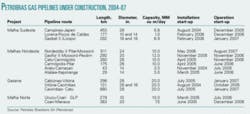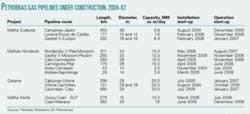Presidents Hugo Chavez of Venezuela, Néstor Kirchner of Argentina, and Luiz Inácio Lula da Silva of Brazil, on Dec. 9 signed an accord for the construction of an 8,000-10,000 km pipeline to transport natural gas from Venezuela to Argentina through Brazil and Uruguay. The line would cost $10-17 billion and could take 5 years to construct.
The presidents signed the agreement in Montevideo during an annual meeting of Mercosur at which Venezuela was accepted as a member.
Petroleos de Venezuela SA, Andean Development Corp., and Brazil’s National Economic and Social Development Bank have signed an agreement to work jointly on financing the project. Other public institutions and private investors will be invited to participate, said Brazil’s Mines and Energy Minister Silas Rondeau.
The Venezuela-Argentina gas line is part of an energy integration accord ratified by Venezuela, Argentina, and Brazil last May.
A preliminary study by the three governments is to be complemented with additional technical and financial data. According to initial estimates, 100-150 million cu m/day of gas would arrive in Brazil at a cost of some $2.60/MMbtu, compared with the $3.60/MMbtu that Brazil pays for gas from Bolivia.
Analysts believe that in 20 years, when existing pipelines are interlinked, the network of pipelines would tap into South America’s most important gas reserves in Venezuela (about 150 tcf), Bolivia (28.7 tcf), Argentina (23.4 tcf), Brazil (9 tcf), and Peru (6.8 tcf).
Venezuela now produces about 80.5 million cu m/day of gas.
Upon returning from Venezuela, Nestor Cerveró, the international director of Brazil’s Petróleo Brasileiro SA (Petrobras), told OGJ that Venezuela’s huge reserves could support a continent-wide natural gas system similar to that in Europe.
Demand strengthening
The next phase of the project includes a profile of markets in Brazil and in the Southern Cone of Latin America.
Ironically, Venezuelan industry faces a serious gas deficit-estimated by some private institutions at 500 MMcfd-which results in its consuming great quantities of more-expensive energy sources to sustain operations.
Although the largest gas reserves are in northern areas of South America, 70% of the continent’s 365 million people live in the south (Brazil, Argentina, Chile, and Uruguay), where the most developed production and pipeline infrastructure are located.
Petrobras expects Brazilian gas consumption to grow at a rate of 12-15%/year. Even during economic lulls, Brazilian consumption has grown at 10%/year, led by natural gas vehicle and industrial markets. Gas demand also is growing rapidly in other South American countries.
Expected pipeline route
Although the exact route for the pipeline has not been defined, estimates for the first 2,950 km section-from Puerto Ordaz, Venezuela, to Marabá, Brazil-call for a 66-in. diameter pipeline with 13 compressor stations of 25,000 hp each and 11 city gates.
Rondeau said gas would arrive in Brazil through Rondonia state. The pipeline would extend south to Manaus, capital of Amazonas state, and continue toward the Amapá state capital, Marabá, south of Belém, capital of Pará state, where it would branch.
In Manaus, the pipeline could be connected to a system that Petrobras is constructing to transport gas produced at Urucu in the Solimões basin-a Urucu-Coari-Manaus line and another from Urucu to Porto Velho, capital of Rondônia state.
The stretch through the highly sensitive Amazon ecosystem likely will attract opposition from environmental groups, and this could delay environmental licenses from Ibama, Brazil’s national environmental agency, as has happened in the past.
In Marabá, a 1,387 km stretch of the proposed pipeline would branch to Fortaleza, capital of Ceará state. The diameter of the pipeline would gradually decrease from 36 in. to 34 in. and 32-in. This also involves the installation of five 15,000 hp compression stations and 19 city gates. About 35 million cu m/day would be distributed from Fortaleza.
In Fortaleza the pipeline can be connected to the existing system that extends along the coast to Salvador, capital of Bahia state. From Salvador, Petrobras is building the Gasene gas line to connect Brazil’s north and south systems. Petrobras is investing $3.9 billion in 3 years to build 4,191 km of pipelines (see table).
From Marabá the transmission line would continue southward in a 1,977 km stretch of 54-in. diameter pipe to São Paulo state. It would include eight 20,000 hp compression stations and 20 city gates and distribute 42 million cu m/day in São Paulo.
From São Paulo the pipeline would be routed to the border between Rio Grande do Sul state and Uruguay and cross Uruguay to Argentina in a 1,875 km section of 38-in. pipeline. This section, including eight 15,000 hp compression stations and 20 city gates, would transport 50 million cu m/d, according to study estimates. ✦

